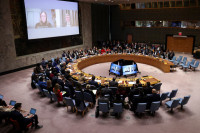Opinion
Achieving ‘mass-based’ status
Nepali Congress should better reflect social composition and concerns
Sarin Ghimire
Nepali Congress is currently engaged in deliberations to reinvigorate its organisational structure with plans to decentralise its organisation along the lines of the country’s new federal constitution. The party has proposed several alternatives to its organisational structure, including amendments to its number of tiers of governance, categories of membership, rights of the party president and inclusive representation in its bodies. However, these amendments are insufficient in attracting youths, who comprises around 40 percent of the total population.
The party, which claims to be a ‘mass-based organisation,’ is in fact purely cadre-based in structure. It has a large number of permanent sympathisers, predominantly because NC has maintained a front seat in Nepal’s major political, social and economic changes over several decades. But times are changing, and so is the level of competition. If the party remains oblivious to society’s evolving dynamics, its age group composition and its growing expectations, the reinforced organisational structure may not be enough to attract new members. Following its heavy defeat, the NC has done little to address its shortcomings.
The central committee meeting to analyse poll results focused largely on pointing fingers. The only commendable act has been the Central Policy and Training Academy’s recent efforts to conduct consultative programs.
Among many factors, a severe dearth of ownership among party leaders and cadres, along with its haywire organisation, were critical reasons for the defeat. While it took two years for the party president to nominate office bearers, central departments are still lying vacant, NC’s disciplinary committee is purposeless, and the youth and student wings are toothless. But the president’s hands are tied by the party’s statute.
Therefore, the president should be given the right to nominate office bearers from within central members whom he/she feels comfortable working with. The same should be applied to fulfilling the party’s central departments and other crucial committees. It is, however, necessary to be wary of streamlining too much power to the president as it could lead to autocratic tendencies. Hence, a majority in the central committee should ratify all major party decisions.
The proposed increase to seven or eight tiers of organisational structure will undoubtedly revitalise its activities. An increase in the number of office bearers as well as the central working committee is also a positive step as it provides space for more members to engage with the public. Most of all, it strengthens its sense of accountability and responsibility.
The power to pick party candidates during local or provincial elections should also be devolved to lower committees as they have a better understanding of ground realities. The center should rather focus on overall plans and policies, including national-level issues and its internal organisational activities. A leader can only be as strong as its party statute. If the leadership is ready to accept the devolution of power, it will be able to devote more time and energy to the overall image and direction of the party.
The process of electing NC’s leadership is democratic, with active members—which is quite exclusive in its own right—electing representatives all the way from the wards to the center level. It is democratic in the sense that leaders are openly allowed to express their views, and voice their dissatisfaction. But does that really benefit their public appeal or do such divisive activities, in turn, derail the image of the party?
If the NC really wants to call itself a ‘mass-based party,’ then it will have to begin with creating only one criteria for membership: open and easily accessible. Apart from being inclusive in terms of electing women and ethnic minorities, the party’s committees should also accurately reflect the composition of the present society and its demands. This includes better representation of youths as they represent the largest voting group and other stakeholders from various socio-economic fields. Only then will the party mirror society, its choice of leadership, and better understand its expectations while running the state.
Most of these issues are still contentious among the top party brass, and several issues are unlikely to be rectified as any changes to the party’s statute will have to be passed by a two-third majority of Mahasamiti members.Deeply rooted leader-based factionalism makes these Mahasamiti members a mere puppet of their group leader. Thus, unless the top brass is willing to use this opportunity to actually revive the party and not just serve vested interests, it will be difficult to increase its voter bank come next elections.
Ghimire is a political economist based in Singapore.




 15.69°C Kathmandu
15.69°C Kathmandu












